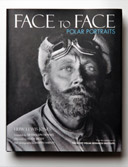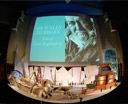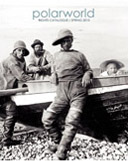 Our ProductsOur Resources |
This website requires the free Flash plugin to be installed.
Polarworld - discover more polar booksThe Arctic Book ReviewCaptain Francis Crozier: Last Man Standing? Michael Smith Reviewed by Russell A. Potter Seconds-in-command are a fascinating if somewhat doleful bunch: their labor is often as great, or greater, than those under whom they serve, and their character is less often blemished by egoism and hubris – after all, if it had been, they’d never have lasted very long in such a nearly commanding position. Sometimes, however, when the firsts are fallen, the story of the seconds takes on a grim and strange fascination; we yearn to see how they will perform when the mantle of responsibility is fitted to their shoulders. Some turn out to be worse than those whose place they take, and some better – and with some, as with Francis Rawdon Moira Crozier, we may never know for certain. The question mark at the end of Michael Smith’s title is a sign of this uncertain regard; from everything we know, Crozier apparently rose to the challenges facing Sir John Franklin’s Arctic expedition of 1845 after the death of its commander – and yet what we know is so limited, so enigmatic, so vexed with fragmentary and contradictory evidence, that we may never discover his ultimate fate. Smith’s is the latest of several books, including David Murphy’s biography of Leopold McClintock (also published by Collins Press) which have highlighted the previously neglected contributions of Irish officers to the British exploration of the Arctic and Antarctic in the nineteenth century. There seems to have been a common makeup to these men, whose character, though molded by the same discipline of the Royal Navy, was often livelier and less rigid than their English counterparts. Sometimes, as with Robert McClure, they demonstrated an impetuous quality that could drive them to seek out greatness at the risk of departing from their official orders; at other times, as with Henry Kellett – ordered by Admiral Belcher to abandon HMS Resolute – they reluctantly obeyed even orders they felt were grievously ill-advised, holding anger in check with dignity. Francis Crozier, from what we know, seems to have been cut from the latter cloth, though he was not entirely averse to private criticisms of his commanders. Smith gives us a vivid and detailed account of the Crozier family’s fortunes, detailing how they, like many others of the professional classes in the northern counties, found their economic interests closer to those of the established Protestant order than to those of the Catholic peasantry and working classes. When his eleventh child, a son, was born to George Crozier in 1796, he underscored the importance of these interests; with the names Rawdon and Moira he honored the prominent family whose heads, the Earls of Moira (surname Rawdon), had been prominent in British colonial government for generations. The elder Crozier, a solicitor by profession, had served the Rawdons for many years, and the association had brought him the comfort and prestige of an established practice, a substantial home, and a broad circle of wealthy clients. Such a household might seem an unlikely one in which a boy might wish to run off and join the Navy, or obtain his father’s blessing if he did so, at the tender age of thirteen. Yet so he did, and found himself almost instantly thrust into the midst of the Napoleonic wars, serving on board ships escorting merchant vessels and transporting troops to the Continent. By a fortuitous set of chance circumstances, however, Crozier found that his ship, the Briton, would soon be quite far from the principal battles; the vessel was ordered to sail ‘round Cape Horn to Chile in pursuit of an American frigate. From there, new orders directed the Briton to the Galapagos Islands and the Marquesas, where the young Crozier encountered a wide range of natural and human history; on the return voyage to South America, the vessel even stumbled upon Pitcairn Island due to a navigational error, and the crew found themselves in company with the descendents of Fletcher Christian and his fellow mutineers. Such an adventuresome voyage must have sparked something in Crozier, who ended up, like so many midshipmen of his day, dismissed from active service after the war’s conclusion. With the reserve of underemployed officers so great, something must have set Crozier apart from the crowd, as he was chosen by Edward Parry for his second Arctic voyage of 1821, taking a place in the junior officers’ mess alongside more experienced men such as James Clark Ross. Ross and Crozier quickly became close friends, a bond which would endure throughout their lives. The voyage of 1821 would test them both, and included two winters spent in the vicinity of the seasonal Inuit settlement of Igloolik. There, by one account – not mentioned in Smith’s book – Crozier made friends with a young Inuk by the name of Aglooka, with whom he engaged in the ancient custom of name-exchange. Aglooka from that time forth gave his name, at least when speaking to Europeans, as “Cro-zhar,” while Crozier became known locally as “Aglooka.” “Aglooka,” as those seeking to trace Crozier’s Arctic achievements have learned to their frustration, was a name associated with other explorers as well, a fact hardly surprising since it translates roughly to “long strides” – a quality which nearly all English officers shared from the Inuit point of view. In any case, Crozier made good use of his sojourn in Igloolik, becoming reasonably proficient in the Inuktitut language, and dutifully taking observations of the weather and tides even in the most difficult of circumstances. Years later, the Inuit remembered that this “Aglooka,” who was an officer less than a captain (an “esh-e-mu-tar-nar”) had promised the people that he would return some day as an “Esh-e-mu-ta” – a captain of his own ship. It was to be many years before Crozier could fulfill his boast. His next two voyages were also under Parry, during which he weathered the wreck of the Fury, helping to cache some of its supplies at Fury Beach, and sailing north again on Parry’s attempt on the North Pole by boat and sledge. This last expedition, in which the man-hauling of sledges over ice was brought – or should have been – to its reductio ad absurdum – saw the lead parties actually lose ground as the ice on which the traveled drifted south faster than they could sledge north. Humiliated by this defeat, Parry retired from active exploration, and by the mid-1830’s Crozier found himself once more without an appointment, and stuck at the rank of lieutenant despite more than two decades of service. Yet his career, as things turned out, was far from over. His friendship with James Clark Ross made him Ross’s first choice for his second-in-command when, in 1839, he was appointed to lead a new expedition to the Antarctic aboard her majesty’s ships Erebus and Terror. Finally the commander of his own ship, Crozier enjoyed the privilege of picking his subordinates, as well as the (not to be underestimated) comfort of the captain’s quarters and a private steward. As Smith notes, Crozier’s position here was in many ways the apex of his career; blessed with the complete confidence of his commanding officer, on an ambitious expedition into uncharted waters, he had a real chance to demonstrate his mettle. The Ross expedition turned out to be something of a mixed success; although it charted a considerable amount of the coastline of Antarctica, including the Ross Ice Shelf and the volcano Mount Erebus, and set a new record for furthest south, it also established that any sea-route approaching closer to the pole would be fraught with enormous peril. It was a fateful voyage in other ways as well, since between his two forays south, Ross docked at Hobart Town in Van Diemen’s Land, where he and Crozier and their crews were the honored guests of Sir John Franklin, who was then serving as Governor of that terrirory. The fancy dress ball held aboard the ships, which Smith recounts in impressive detail, was not only the event of the year for Hobart Town, but perhaps the most remarkable gathering in the history of polar exploration to that point. As Smith describes it, Visitors approached the vessels aboard a makeshift gangway made from a line of boats strung together and decorated with flags and wattles, the floral emblem of the island. A large canvas awning was thrown across the ships, with the upper deck of the Erebus fitted out as the magnificent ballroom and the dazzling supper tables assembled around the Terror’s upper deck. More than 250 mirrors were arranged on the sides of the ships to reflect the flickering candlelight. With Sir John Franklin in his dress uniform presiding, with Lady Franklin and Sophia Cracroft by his side, the “Two Captains” the object of every woman’s dance card, the 250 mirrors (one wonders if these were the colony’s entire stock!) must have reflected quite a sight indeed. The irony, noted by Smith, that these same decks, only a few years hence, would be the abode, and eventually the tomb, of the sailors under Franklin’s and Crozier’s command, gives this gay scene a somber coloration, rather like the parties on board the Titanic on the evening of April the 12th. The vessel’s sojourn in Hobart Town was also the scene of a further twist of fate, as Crozier apparently fell deeply in love with the one woman in the entire crowd who would have none of him – Sophia Cracroft. Accustomed to the constant company of Lady Jane, with whom she would trade snips and glosses on the sundry shortcomings of any potential mate, Sophie was having far too much fun to allow her life to be re-shaped around a Naval officer, however illustrious. The disappointed Crozier sailed off a few days later on the second, and as it turned out, most perilous leg of his and Ross’s Antarctic venture. Buffeted by heavy ice, the ships painfully threaded their way south, realizing after six weeks in the perilous pack that the season had grown too far advanced for any further progress. The route back to their wintering port in the Falkland Islands proved even more perilous, as they weathered two severe storms punctuated by lingering pack-ice, as well as third gale out on the open seas. Both ships lost their rudders, and one of Ross’s men was swept overboard and drowned; Crozier, as ever, kept his composure throughout, earning fresh respect from his amazed crew. A third year in the ice, which turned out to be the most frustrating of all, followed after that, after which the ships’ final return to England must have stirred, above all else, feelings of relief. The reception in England was glorious, though more so for Ross, who received a knighthood, than for Crozier, who though at last promoted to the rank of Captain, found himself once more without a ship. Not long after came the return of the Franklins, summoned home from Tasmania under the cloud of a political coup engineered by Sir John’s colonial secretary. This enabled Crozier to make a fresh attempt on Sophie’s affections, from which he suffered the humiliation of a second rebuff. Crozier took a year’s leave from the Navy, and headed to the Continent to seek some relief from his depressed state of mind. It was in this context that, when rumors of a new attempt on the Northwest Passage reached him, Crozier learned that his old friend Ross, though offered the command, had demurred, but stood ready and willing to lobby for Crozier as the second to whomever was chosen. Smith notes, quite rightly, that Crozier needed to act quickly if he was to have any chance at all, and that he may still have held out hope that service with Franklin would somehow help his standing with Sophie. In the end, Crozier did indeed receive the post of second under Franklin, though under peculiar and unsettling circumstances. For some reason, whether patronage or political favoritism, the customary privilege of selecting the subsidiary officers, almost always placed in the hands of the second, was given instead to James Fitzjames, some years Crozier’s junior and a man with no Arctic experience whatsoever. This must have been a blow to Crozier, though he apparently took it in good humor, but more significantly it was a blow to the fitness of the expedition as a whole. Not surprisingly, Fiztjames picked out as his subordinates a group of men with as little Arctic experience as himself; most had only lately been stationed in China in connection with the Opium Wars. The final result was that, of all the senior officers, only Franklin, Crozier, and the two “Ice Masters” had any substantial Arctic experience. This, as much as any of the well-known problems with provisions and preparedness, may have compromised the Franklin expedition from its start. For Crozier, whose powers of personnel were limited to choosing his personal steward, there was a new sense of isolation and awkwardness; in a letter posted to Ross from Greenland he lamented that he had “no congenial spirit” on board the Terror. Though he admired Franklin, he wondered whether his commander was truly fit for the rigors of the ice, which – in terms of commanding a Naval vessel – Franklin had not experienced in nearly thirty years, since his service under Buchan in 1818. Again to Ross, he expressed private doubts about Franklin’s judgment, concluding that “I fear we will blunder in the ice.” Most of all, he badly felt the absence of Ross, to whom he wrote in his last letter “I wish you were here, I would then have no doubt as to our pursuing the proper course.” These doubts, though made much of by some (most recently in Channel 4’s documentary “The Search for the Northwest Passage,” which found room to quote them twice!), don’t seem to have formed the whole of Crozier’s view. In his other letters to family members, he spoke of the camaraderie and high spirits of the crew, and if he did not share their confidence that they would make it through, as Fitzjames did, “in a season,” that was the result of experience rather than pessimism. The fullest picture we have of him, perhaps, is in the daguerreotype by Beard, which is prominently featured on the dust jacket of Smith’s book (though inexplicably credited to “photographer unknown”). One can see something of the melancholy of the man, but also a sense of stoic determination; it seems inconceivable that this man, whatever his personal moods, would do anything other than his utmost in service to the goals of the Expedition. Now the ships entered waters equally dangerous to captain and biographer, with shoals of broken and scattered evidence, shallows of conjecture, and the variable winds of Inuit testimony. For the most part, Smith steers the reader adeptly through these hazards. There are points on which historians may differ; Smith holds to the older view that Crozier was making for the Hudson’s Bay outpost near Great Slave Lake, a foolhardy destination to anyone who knew the landscape of the Barren Lands. The view of David Woodman, that the 1848 abandonment was simply meant as a search for game, represents the other end of the spectrum. I personally am convinced that Crozier must have been making for some nearer goal, either in the vicinity of Repulse Bay or to Fort Churchill, both of which were considerably nearer. This route would also have the advantage of increasing possible contact with Inuit or whaling vessels. In several of the Inuit stories, the “Aglooka” who tells of the ships being crushed by the ice declares that he is headed to “Iwillik” (in modern orthography "Aivilik," the area around Repulse Bay). Indeed, though at times inconsistent, these stories are remarkably detailed, and it’s too bad that Smith does not draw from them at greater length. Of course, there is the difficulty already noted, that “Aglooka” may refer to any of several explorers, or to any white man, but in these tales at least there is some sense of what Crozier, or the officers delegated by him, did in their last attempts to seek succor. Nevertheless, Smith offers enough of a selection from the Inuit accounts to give the reader a general sense of the events as the Inuit witnessed them. He is stronger when summarizing the evidence brought back by Rae and McClintock, and his account of the gradual emergence of the full scope of the Franklin disaster is one of the richest sections of the book. Crozier emerges only in glimpses, but that is as it must be – until, at least, some written record emerges. The Inuit who described the meeting with Aglooka said that he was ‘making marks on paper’ – writing, as Hall readily deduced – and if these writings were to be found, all other histories would be swept aside. Until that time, if it ever comes, Crozier could have asked for no better biographer than Michael Smith. Painstaking in his research, judicious in his verdicts, and a gifted storyteller as well, Smith achieves a rarity in Polar biography: a page-turner which neither stints on historical detail nor gussies up the facts with the sort of dramatized fictions which have become so common of late. We keenly feel the loss of Crozier, who finally steps forth from behind the shadow of Franklin to take his own well-earned place in the history of Arctic exploration. |
|
||
follow us  | join us | join us  | home | contact | home | contact
|
||||
|
© Copyright Polarworld Ltd
SiteWizard.co.uk Web Site Design Company |
||||


